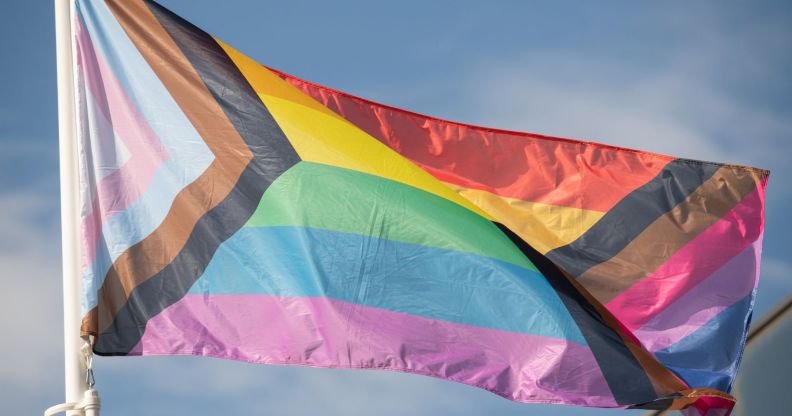People are losing their minds over the bi-inclusive Progress Pride flag

People are losing their minds over Sadiq Khan sharing a picture of the bi-inclusive Progress Pride flag (Mayor of London Sadiq Khan)
People have expressed outrage after Mayor of London Sadiq Khan posted a photo of a Progress Pride flag featuring the stripes of the bisexual flag.
The Labour politician posted the photo to celebrate Trans Day of Visibility on Sunday (31 March), with the flag bearing the traditional rainbow colours, the trans flag, brown and black stripes to represent the inclusion of people of colour, as well as the pink, purple and blue stripes of the bi flag.
While several social media users had genuine concerns about the flag, such as the intersex symbol being left off of the flag design, many were aghast at the inclusion of just three more colours.
What is the bi-inclusive flag?
The original LGBTQ+ Pride flag, featuring pink, turquoise and violet within eight stripes, was designed in 1978 by Gilbert Baker. It was then modified to seven stripes, due to the unavailability of pink fabric, before turning into the currently recognisable six-colour rainbow design in 1979.
Since then, versions have been updated into the ‘Progress’ Pride flag, with Daniel Quasar designing the one with black and brown stripes in 2018, to represent people of colour. Stripes of baby blue, pink and white were later added to represent the trans community.
The bisexual-inclusive flag seen in Khan’s tweet also incorporates blue, purple and pink, the colours of the bi flag, to represent bisexual people.
The reaction to the Progress flag has been mixed, with many LGBTQ+ people welcoming the various new designs, but right-wingers reacted with vitriol to the inclusion of transgender people, and flags have been vandalised, burnt and compared to the Nazi Swastika by bigots.
The bi-inclusive flag has prompted even more outrage, with several queer social media users branding it “ugly”, and some bisexuals adding that they already felt included by the original rainbow flag.
Is the flag the ‘new’ Progress Pride flag?
The bi-inclusive Progress Pride flag isn’t new. Mayor Khan has been flying this version outside his offices since at least 2018, and there are several flags dedicated to representing different identities within the LGBTQ+ community.
The bi-inclusive flag is simply another design people can choose to wave to honour the LGBTQ+ community, or to draw attention to the erasure the bisexual community often faces.
Khan, who has previously been targeted because of his support for the LGBTQ+ community, told Forbes: “This flag recognises intersections within the LGBTQ+ community, honouring LGBTQ+ people of colour – whose activism inspired the very first Pride – as well as different gender identities.”
How did this story make you feel?

